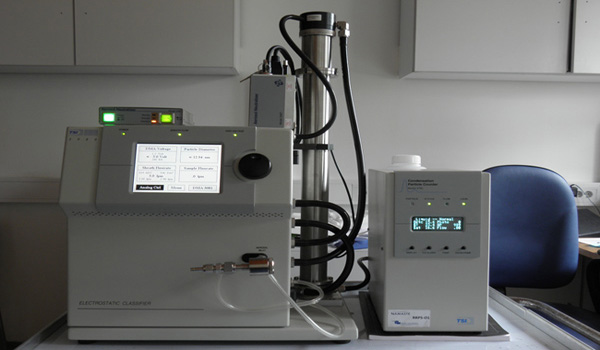equipment - Scanning Mobility PArticle Sizer (SMPS)

TSI SMPS 3936L85
TSI's Scanning Mobility Particle Sizer Spectrometer 3936 spectrometer is a high resolution nanoparticle sizer that has long been hailed as the researcher's choice for nanoparticle size characterization for nano applications including nano research and development.
SMPS™ spectrometer sizing is a discreet technique in which number concentrations are measured directly without assuming the shape of the particle size distribution. The method is independent of the refractive index of the particle or fluid, and has a high degree of absolute sizing accuracy and measurement repeatability. Trusted by researchers, the TSI Scanning Mobility Particle Sizer™ Spectrometer (SMPS) has provided high quality data for over 30 years.
It is composed of two parts:
Electrostatic Classifier

The Model 3080 Electrostatic Classifier can be used with either Differential Mobility Analyzer (DMA): Long or Nano, as the main component for generating or sizing aerosols. Given a polydisperse input aerosol, the instrument output can be a stream of monodisperse aerosol of known particle size (particle electrical mobility). Electrostatic Classifier separates particles by size for high-resolution measurements of particle size distribution. When used in TSI Scanning Mobility Particle Sizer (SMPS) spectrometers, for example, monodisperse aerosol exiting the Electrostatic Classifier passes to a Condensation Particle Counter (CPC), which measures particle number concentration. By scanning quickly through a portion of the size range from 2 to 1000 nanometers (size range varies by SMPS configuration), the SMPS measures the size distribution of the aerosol precisely.
Condensation particle sizer
 The Model 3785 UWCPC is a water-based Condensation Particle Counter designed to measure the concentration of airborne ultrafine particles. In operation the WCPC draws in an air sample and counts the number of particles in that sample to provide a particle concentration value that is displayed as the number of particles detected per cubic centimeter of sampled air. The UWCPC uses a laser and optical detector to detect the particles, passing the sampled flow through a viewing volume illuminated by a laser. The instrument relies on a condensation technique to deposit a working fluid on the particle to grow or “amplify” their size to a value that can be detected readily with a conventional optical system. This instrument utilizes a new patented technology (Aerosol Dynamics Inc. Berkeley CA) that allows water to be used as the working fluid without the requirement of mixing or adiabatic expansion techniques. The aerosol sample is uninterrupted and follows a laminar-flow path from the sample inlet to the optical detector.
The Model 3785 UWCPC is a water-based Condensation Particle Counter designed to measure the concentration of airborne ultrafine particles. In operation the WCPC draws in an air sample and counts the number of particles in that sample to provide a particle concentration value that is displayed as the number of particles detected per cubic centimeter of sampled air. The UWCPC uses a laser and optical detector to detect the particles, passing the sampled flow through a viewing volume illuminated by a laser. The instrument relies on a condensation technique to deposit a working fluid on the particle to grow or “amplify” their size to a value that can be detected readily with a conventional optical system. This instrument utilizes a new patented technology (Aerosol Dynamics Inc. Berkeley CA) that allows water to be used as the working fluid without the requirement of mixing or adiabatic expansion techniques. The aerosol sample is uninterrupted and follows a laminar-flow path from the sample inlet to the optical detector.
Find out more about our air-quality measurements...



